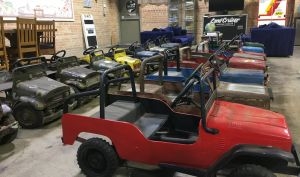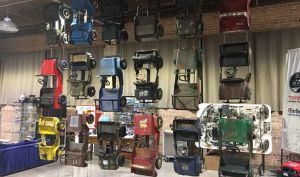The History of Pedal Cars
When the automobile made its appearance, the pedal car soon followed. Pedal car history goes back to the 1890's when most were modeled from the real cars on the road at the time. Since their conception, pedal cars were all kids wished for. But at the turn of the century, their cost meant they were playthings for only wealthy families. With many families reeling from the financial devastation of The Great Depression, pedal cars were often toys for upper class children. Those not so fortunate played with basic homemade ride-on toys. In the 1920's and 1930's the wealthy were catered to when it came to buying pedal cars since they were the primary buyers. No pedal cars were produced in the mid-1940's when all metal production was directed to the World War II effort.
Reaching the peak of popularity in the late 1920's and early 1930's, pedal cars experienced a resurgence in the 1950's to 1960's with chain-driven models. With postwar prosperity in the 1950's, pedal cars grew more popular and were available in all major stores. From the early 1920's through the late 1960's, pedal cars, like automobiles, were produced in many different models and colors. Designed to incorporate the most current trends of the automotive world, pedal cars featured working lights and horns, moveable windshields and ragtops, chrome detailing and hood ornaments, and white wall tires and custom paint jobs.
Later pedal toy manufacturers recognized that there was a huge market for these pedal car ride-on toys and extended their business strategies to include manufacturing of other pedal toy products like pedal planes, namely the Red Baron, Shark Attack and Fantasy Flyer. Manufacturers later extended their idea of the pedal car to all things pedal, including pedal trains, pedal trucks, tricycles, and even die cast models for those who just wanted a model of the models. The idea of owning one of these pedal toys is trendy to this day as many pedal toy owners are not only purchasing these products as gifts for their children, but also as collectible items. They have an emotional attachment to the memory that these cars bring to them. Once upon a time, they were in the original versions of these cars.
In the 1960's, a fascination with space and air travel, the ubiquity of plastics, and new safety standards for toys brought an end to widespread metal pedal car production. In the 1970's the plastic car was introduced and the traditional steel pedal cars almost faded out of existence. Children's car manufacturing continued in plastic, but the design of the vehicles no longer captured the aesthetic of adult automobiles. The pedal car era began almost as soon as the world embraced the automobile and ended when metal toys gave way to plastic.
The Land Cruiser Heritage Museum would like to thank Luke Bogner and Mike Bradshaw for loaning their collectible pedal car(s) to be displayed at the Land Cruiser Heritage Museum.
Courtesy of pedalcarplanet.com







